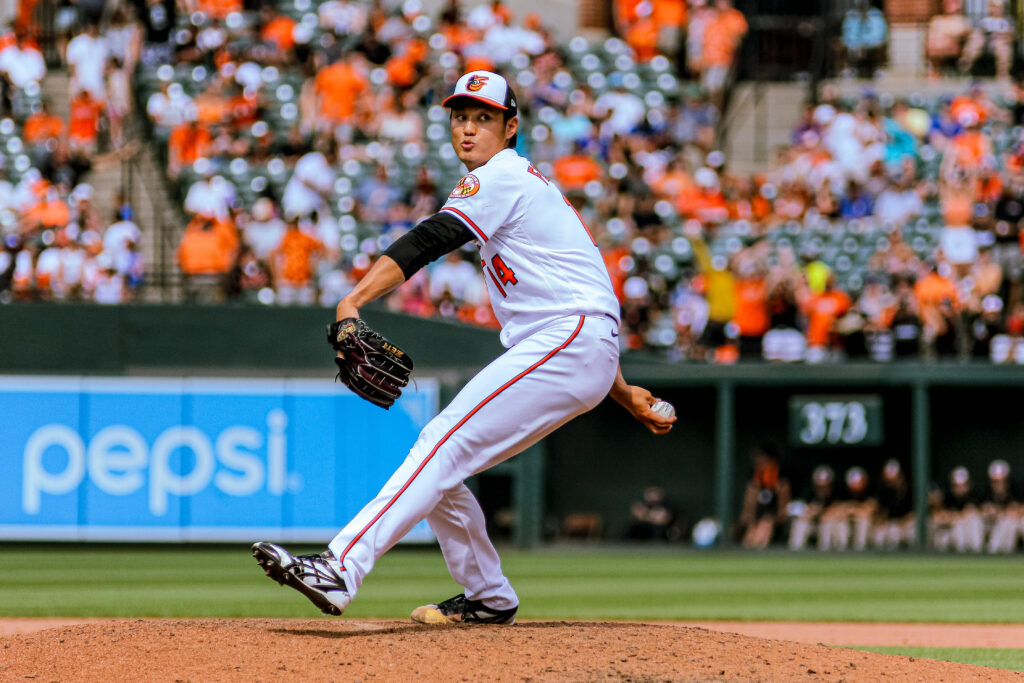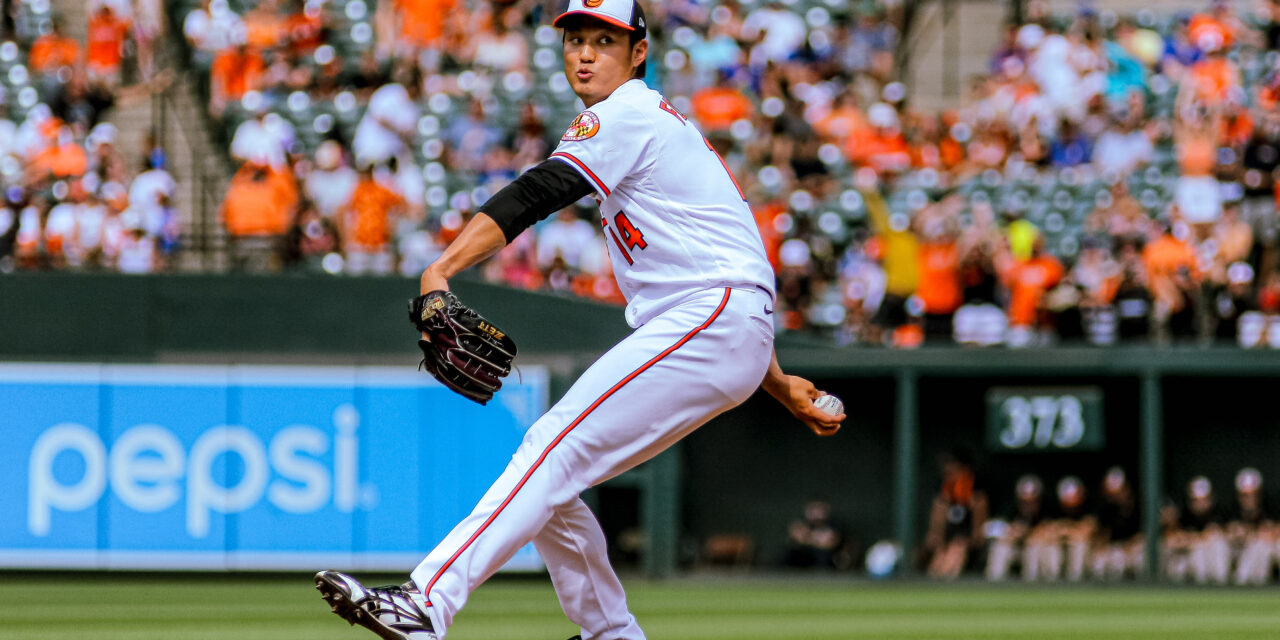After bolstering their bullpen with the signing of left-handed reliever Jake Diekman on Friday, the Mets subsequently inked Japanese flamethrower Shintaro Fujinami to a one-year, $3.35 million contract. Fujinami, 29, will add a much-needed uptick in velocity to the Mets bullpen, along with his counterpart Diekman and the returning Edwin Díaz.

Photo by Roberto Carlo
NPB Beginnings
The 6-foot-6 right-handed pitcher’s story began with ten seasons of experience in the Nippon Professional Baseball scene. He accumulated a lifetime 3.41 ERA in the NPB, along with 1,011 strikeouts in 994 1/3 innings. Fujinami’s best season came back in 2015 when he struck out 221 batters in 199 innings. He also had an impressive 2.40 ERA in 28 starts with a 14-7 record.
While his performance varied after that stellar season, he returned to excellence in the 2022 season. He struck out 115 batters in 107 1/3 innings, in addition to his 2.77 ERA and 1.118 WHIP. Fujinami’s most considerable development in 2022 was his improved control, earning a walk rate of three per nine innings. When juxtaposed with his 2021 figure of 6.3 walks per nine innings, it is clear that Fujinami turned a corner with his previous control issues.
Despite an outlier season in 2022, Fujinami has frequently struggled with control, negatively impacting his overall success. His 2021 season was characterized by struggle, accumulating a 4.21 ERA and 1.654 WHIP in 87 2/3 innings. Another example of the correlation between Fujinami’s high walk rate and lack of success is his 2017 season, in which he walked 76 batters and hit 11 with a pitch in only 120 innings.
This means that Fujinami allowed a runner to reach base due to a walk or hit by pitch in nearly 73 percent of his innings. Factoring in the 103 hits he allowed that season, Fujinami’s command struggles display an alarming trend in Fujinami’s career where he has been unable to reach his full potential.
MLB Struggles
After accumulating these formative years of experience in the NPB, Fujinami took his talents to the Oakland Athletics. He agreed to a one-year, $3.25 million contract with the club in the 2022 offseason, and the plan was for Fujinami to operate as a starting pitcher.
However, that plan would quickly go south, as Fujinami’s unimpressive 14.40 ERA in just four starts would prompt his transition to the bullpen. Besides his quality start against the Mets on April 15, Fujunami lasted no more than 4 1/3 innings in the other three starts, allowing 21 earned runs in only nine combined innings. He also allowed ten walks between those three starts, showcasing the disastrous ramifications of his control issues that dated back to his NPB career.
Upon entering the bullpen, Fujinami continued to see disastrous results, earning a 10.66 ERA in his first ten appearances. His walks continued to be an issue, as he walked 12 in 12 2/3 innings. His woes soared beyond walks, as he surrendered 15 hits in that span.
Consequently, Fujinami finally began to see a stretch of success after that horrific start. From May 27 to July 18, he appeared in 20 games, accumulating a 3.32 ERA, 3.99 FIP, and 22 strikeouts in 21 2/3 innings. Most notably, he saw improvement with his control issues, only walking six batters in that span.

Photo by Roberto Carlo
Fujinami’s improved play caught the eye of the Baltimore Orioles, and they secured the reliever in a trade that sent minor league reliever Easton Lucas to Oakland in a one-for-one swap. The rookie would be going from the worst team in the league to a young, up-and-coming team in the playoff race. While this transition would generally motivate players, it is highly possible this could have been a jarring transition for Fujinami, as he was still acclimating to an entirely new country.
That said, Fujinami’s tenure with the Orioles was rocky at best. While he displayed flashes of success, he was unable to remain consistent enough to secure a spot on their playoff roster. In 29 2/3 innings, he had 32 strikeouts and 15 walks with a 4.85 ERA and 4.13 FIP. Beyond these numbers, his 42.9 percent ground ball rate and 33.8 percent hard-hit rate indicate that Fujinami has the makings of an effective reliever who can generate strikeouts and soft contact on the ground.
Besides one poor outing where he allowed three earned runs in 1/3 of an inning, Fujinami’s best production came in September. Excluding the aforementioned outing, he only allowed two earned runs in 9 1/3 innings with ten strikeouts and five walks. This encouraging stretch to finish the season made Fujinami an attractive free agent candidate for the Mets.
When looking at Fujinami’s season from start to finish, the numbers do not appear to be inspiring:
2023 Traditional Stats: 64 G, 79 IP, 7-8, 7.18 ERA, 1.494 WHIP, 83 SO, 45 BB
2023 Advanced Stats: 57 ERA+, 23.3 SO%, 12.6 BB%, 4.80 xERA, 4.61 FIP, 5.05 xFIP, 0.2 fWAR, -2.1 bWAR
A Fresh Start
However, he does possess some redeeming qualities that likely provoked the Mets to sign him to a contract.
Fujinami’s velocity is arguably his most appealing attribute, as his fastball can eclipse triple digits. He used his fastball 56.6 percent of the time in 2023 with an average velocity of 98.4 mph. Despite the high volume of fastball usage, Fujinami accumulated a 25.5 percent whiff rate with the pitch, showing that it can remain effective with high usage. In addition, his 11.1 inches of horizontal break on his fastball is 2.4 inches above the average figure, showcasing the deceptiveness of the pitch when paired with its high velocity.
Mets have signed hard thrower Shintaro Fujinami per @JonHeyman
— Mike Mayer (@mikemayer22) February 2, 2024
While he is adept at missing bats with the fastball, his splitter and cutter are responsible for the majority of his 30.1 percent whiff rate, which ranks him in the 78th percentile among qualified pitchers. He used his splitter 20.1 percent of the time with an average velocity of 92.8 mph while generating a 37.2 percent whiff rate. Similarly, his cutter generated a 38.2 percent whiff rate while only being used 16 percent of the time. His average velocity of 88.2 mph with the cutter demonstrates his potential to confuse hitters, as it is over 10 miles per hour less than his average fastball velocity.
He also deployed a sweeper that he only used 6.1 percent of the time while generating a whiff rate of 27.3 percent. Furthermore, he featured a slider that was hit hard, with minimal usage at 1.2 percent and a .750 batting average against it.
When examining his repertoire, it is clear that his splitter and cutter are his most deceptive pitches. That said, it might be wise for Fujinami to mix his pitches a little more so that he can fool batters more often with the difference in velocity among his three pitches.
Final Thoughts
Overall, it might help that Fujinami will start on a blank slate with a new team this season after a chaotic rookie campaign. Going into spring training to serve as a reliever will likely benefit both the Mets and Fujinami, as they can plan a productive time in Port St. Lucie centered around his development in the bullpen. In addition, Fujinami will reunite with his fellow countryman and 2017 World Baseball Classic teammate Kodai Senga, (see a picture of the pair here) which could aid in his acclimation to the dynamic New York environment.
















